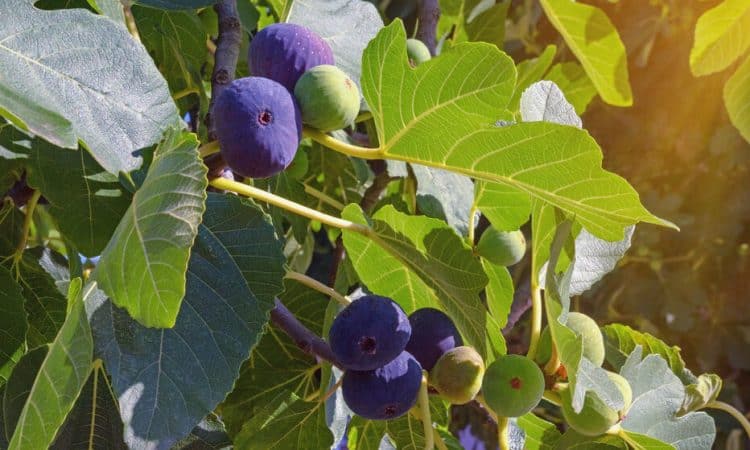
With its elegant foliage and generous, twisting habit, the fig tree is a fruit tree with undeniable ornamental qualities.
And its delicious fruit, figs, add to its charm. In this article, you will learn everything you need to know about growing a fig tree in your garden.
Whether eaten raw, cooked, poached, roasted, or even dried, figs are a gourmet fruit that brings back memories of summer and vacations in the South of France. For a touch of the exotic in your garden, the fig tree is a sure bet.
What is the best place to plant a fig tree?
Very adaptable, the fig tree is an easy-to-grow fruit tree that delights us with its delicious fruit and life-saving shade in the summer.
Location: Since it loves heat, the fig tree likes full sun and the shelter of a wall to protect it from cold winds. The roots of the fig tree are very deep, so it’s best to keep it about 3 meters away from a house to avoid damaging the foundation.
Soil: The fig tree is undemanding in terms of soil, although it prefers light, well-drained substrates.
How to plant a fig tree?
While it’s possible to grow a fig tree from seed, it’s easier to try cuttings or layers.
Once the young fig tree’s roots are well formed, you can plant it outdoors in the spring. To do this, dig a hole in the ground, add some compost before placing the young fig tree, then cover the roots with soil and compact lightly. If you want to plant several fig trees next to each other, keep them about 3 meters apart to prevent them from getting in each other’s way.
How do I care for my fig tree?
Relatively undemanding, fig trees are easy to care for.
Watering: Once well established, fig trees can withstand temporary droughts. In the early years, water regularly during hot spells. Because fig trees don’t tolerate standing moisture, which can rot their roots, it’s best to wait until the soil is dry before watering.
Pruning: During the first few years of the fig tree’s life, prune at the end of winter, before vegetation resumes, to encourage branching. When mature, prune your fig tree only to maintain its silhouette, as its hollow wood does not heal well.
Diseases and Pests: Fig trees can be attacked by a number of pests, including black fig fly, fig scale, gray mold, coral disease and mosaic. Since there is not always an effective curative treatment, it’s best to monitor your fig tree regularly and take action as soon as possible to prevent the spread of these pests.
Cold Protection: Fig trees are relatively hardy. To help it survive the winter, especially if you live in northern France, mulch generously around its base and place a winter veil over its branches.
Does the fig tree grow quickly?
The fig tree is a fast-growing tree, growing about 1 m per year in its first few years. When planted in optimal conditions, it can reach a height of 10 m. Fruit production is also rapid, with the first figs appearing only 2 years after planting.
How long does a fig tree last?
The fig tree has a long life expectancy, up to 300 years.
When do you pick figs?
The fig is a fruit that stops ripening when it is picked. That’s why it’s best to pick them when they’re ripe, from August to October, depending on the variety, when the skin is smooth and colorful. Figs should then be eaten quickly, as they do not keep for more than two days, even in the refrigerator.
Note that fig leaves and sap can be irritating, so protect your hands with gloves when picking.
What’s the best variety of fig tree?
To be sure of enjoying delicious fruit, you need to choose your fig tree carefully. Only female fig trees produce edible fruit, and self-fertile varieties don’t need another fig tree nearby to bear fruit. Here are some of our favorite fig varieties:
- The ‘Goutte d’or‘ fig tree (Ficus carica ‘Goutte d’or’) is a bifruiting variety that is noted for its hardiness and productivity. It produces large, yellow-skinned fruits with sweet, juicy flesh;
- The ‘Ronde de Bordeaux‘ fig (Ficus carica ‘Ronde de Bordeaux’) is particularly hardy and vigorous and adapts well to the climates of the various regions of France. Its figs are small, almost black fruits with a pronounced taste;
- The ‘Blanche d’Argenteuil‘ fig (Ficus carica ‘Blanche d’Argenteuil’) is an old variety that bears fruit in September. It is well adapted to the climate of the coldest regions north of the Loire;
- The Dalmatian fig (Ficus carica ‘de Dalmatie’), very resistant to cold, is a small variety particularly suited to humid regions. It produces delicious, sweet fruit with a light green skin;
- The ‘Figality‘ Dwarf Fig (Ficus carica ‘Figality’) is a compact variety ideal for planting in pots to decorate a balcony or patio. When fully grown, it measures about 1.5 m high and wide;
- The Brown Turkey Fig (Ficus carica ‘Brown Turkey’) is a bifoliolate, hardy variety that adapts well to regions with cold winters. Its tasty fruit has a beautiful brown to red skin.

